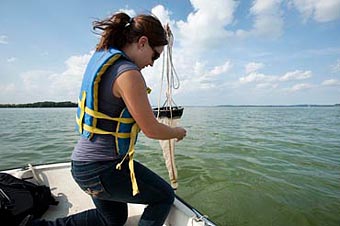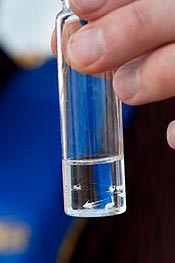UW-Madison undergraduates make unwelcome discovery in Lake Mendota
On Sept. 11, a standard cruise on Lake Mendota’s University Bay began for students in UW–Madison’s Zoology 315, a course that introduces them to the study of lakes. With the sampling craft Limnos anchored about one-quarter mile offshore on a clear sunny day, four students pulled up a small net and began poking through its contents.

On Sept. 15, 2009, Joanna Klass, a UW–Madison junior with a double major in zoology and biological aspects of conservation, pulls up a plankton net cast in Lake Mendota. She next filtered the contents and found spiny water fleas in the sample.
Photo: Jeff Miller
The net was intended to catch plankton — free-floating plants and animals — and as the students dumped its contents into a jar, they asked Jake Vander Zanden, an associate professor at the Center for Limnology, to take a look. “I was struck by what looked to be spiny water fleas,” he says.
About 20 years ago, these carnivorous crustaceans, which are not insects at all, invaded the Great Lakes, and biologists have watched them devour the native zooplankton that graze on algae and help clarify the water — always a concern with overfertilized lakes like Mendota.
Vander Zanden happened to be an expert on invasive species that are disturbing lakes in the Midwest, including the spiny water flea. “I did a double-take,” he says. “I thought, ‘They are not supposed to be here.'”
But the sample was teeming with the invading water fleas, which are easily identified because of their large size and a nasty spine hanging off the tail end. That spine protects the crustacean by making it inedible to small fish, which is a second reason that the spiny water flea is harmful to the lake.

Jake Vander Zanden, an associate professor in zoology, holds a small jar of spiny water fleas collected from Lake Mendota.
Photo: Jeff Miller
The find was the most significant discovery from an undergraduate limnology trip, says Vander Zanden. “I don’t normally go on class field trips expecting to find something like that. It was a beautiful, sunny day, and it was kind of exciting, but definitely not the kind of excitement I want.”
The students who brought up the catch included Seth Pelock, a senior biology student, and Joanna Klass, a junior with a double major in zoology and biological aspects of conservation. “It was my first trip on Lake Mendota, and I was pretty excited; we got to do all these experiments,” Klass says. “It was pretty funny, Jake took it and did not say anything, just stared at the jar. He walked around, and then said, ‘Omigosh, this so weird.’ He could not believe what was in there, but it was kind of bittersweet” when Vander Zanden announced that they had discovered the arrival of a new invasive species in the lake.
“There was shockingly little of the normal zooplankton in the net, but a lot of spiny water fleas,” Vander Zanden says. The high level of invasives and algae, combined with the paucity of the native, grazing plankton, suggested that the spiny water flea could already be damaging the lake.
Long term, the invasion could be bad for water quality, as the spiny water fleas prey on planktonic animals that eat algae and help clarify the water.
“I was already very interested in conservation, but being out there and actually finding this animal told me, ’I can do research. I can find new things.’ It gave me a sense of what it feels to be out there, doing hands-on research and finding new species.”
Joanna Klass, a UW–Madison junior with a double major in zoology and biological aspects of conservation
It’s impossible to be sure how the species reached the lake, but the most likely route is via boats that were previously in Lake Michigan, where the flea has been established for decades.
The discovery is another example of the need for boaters to clean their crafts whenever they pull their boats from the water. “It is vital that Wisconsin boaters and anglers take simple prevention steps,” says Jeff Bode, the lakes and wetlands section chief at the Wisconsin Department of Natural Resources (DNR). “Invasive species affect things we all care about: water clarity, good fishing, clean beaches. And as this recent finding demonstrates, prevention is always the best option because once they are in a lake, removal is often impossible.”
To prevent further alien invasions, the DNR requires boaters to remove all plants and animals from boats, trailers and equipment, and to drain all water from boats and equipment before leaving a water body. The DNR recommends that people either rinse boats with hot or high-pressure water, or allow them to dry for five days.
The Mendota discovery reflects the kind of practical reward from hands-on science instruction that professors often dream of. Klass says, “I was already very interested in conservation, but being out there and actually finding this animal told me, ‘I can do research. I can find new things.’ It gave me a sense of what it feels to be out there, doing hands-on research and finding new species.”
Nonetheless, the flea’s appearance in Lake Mendota is bad news, Vander Zanden says. “I knew they were going to spread, but I expected they would show up first in lakes closer to Lake Michigan.”
Exactly how the flea will change the complex ecology of Lake Mendota cannot be predicted with certainty, says Vander Zanden, noting that good pre-invasion data exists for only one other small lake, in the province of Ontario.
An enormous database on conditions in Lake Mendota stretches back more than 100 years to the start of the limnology studies at UW–Madison, Vander Zanden adds. “This invasion provides a great opportunity to understand how this invasion will impact lake ecosystems. We need to see how this will play out, but we have little reason to think the changes will be positive.”




